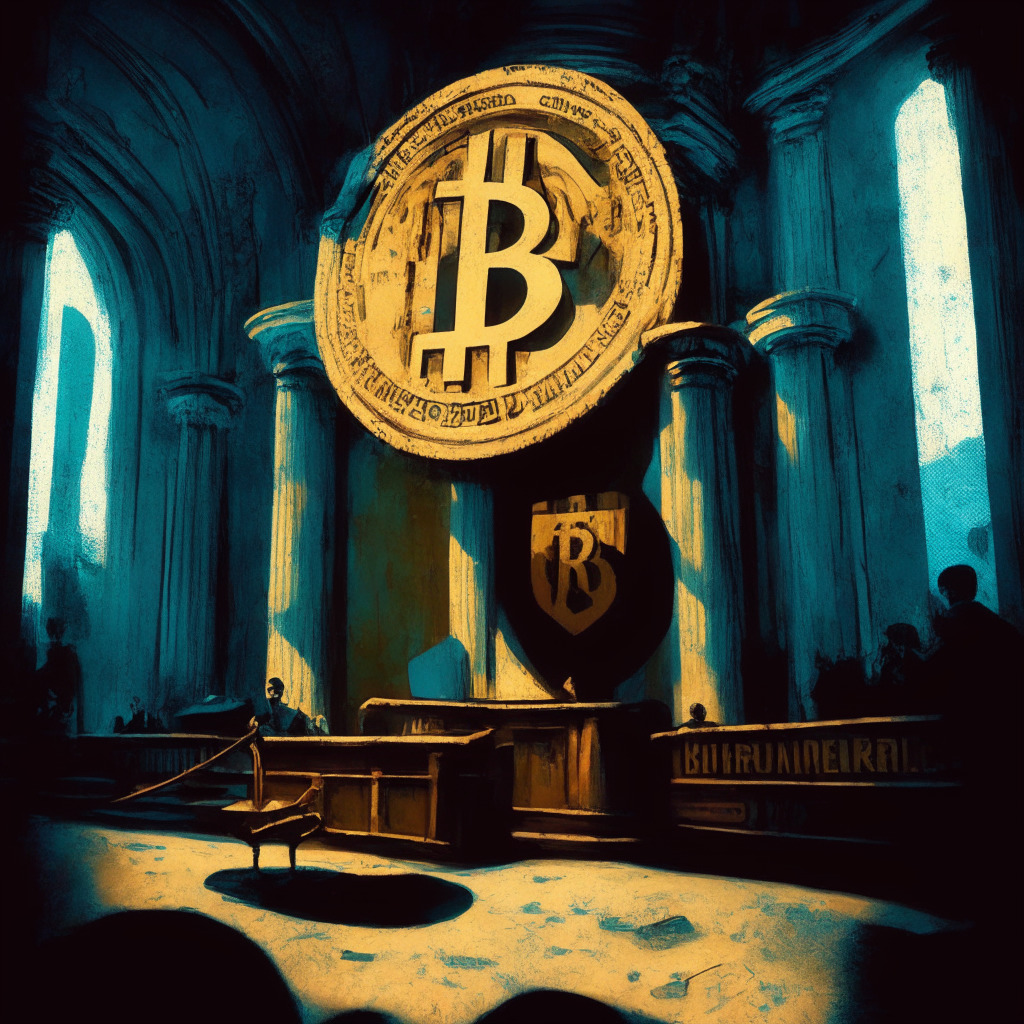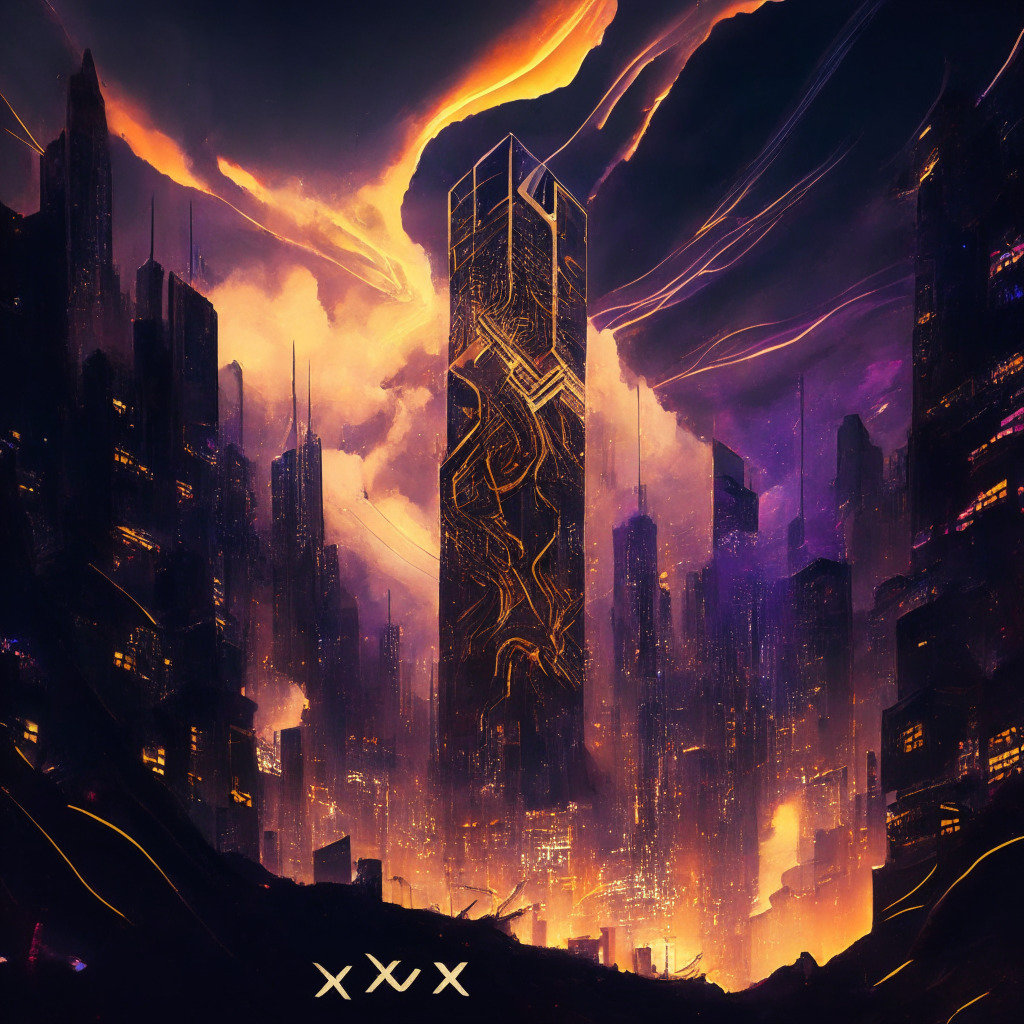“This article discusses Singapore’s largest bank, DBS, leveraging blockchain technology in a ‘gamified adventure’ addressing global food wastage. However, potential issues concerning unregulated financial activities with cryptos, legal confrontations, and uncertain regulatory landscapes are highlighted, illustrating the complexities of global blockchain adoption.”
Search Results for: Ethereum Foundation
Aptos Token Surge and Decline? The Microsoft Partnership vs the Looming Token Unlock
The APT token recently saw a 15% market price surge following news of a partnership with tech giant Microsoft but looming uncertainty remains due to the upcoming unlock of 2% of its supply, worth $33 million. Despite concerns about its tokenomics strategy, Aptos Labs is set to expand its product line with Microsoft’s advanced AI technology.
Hinman’s Emails: Ripple’s Legal Hopes Dashed or Catalyst for Crypto Regulatory Change?
William Hinman’s released emails from the SEC’s ongoing lawsuit against Ripple reveal little new information but may fuel public support for changes in cryptocurrency regulations. Legal experts remain skeptical about these emails aiding Ripple’s defense, however, it could potentially amplify calls for regulatory changes in the crypto landscape.
SEC vs. Ripple: How Hinman’s Decentralization Views Shape the Future of Crypto Regulation
The SEC’s modification of William Hinman’s biography page has sparked speculation among digital asset enthusiasts, given his relevance in the ongoing Ripple-XRP case. Hinman’s 2018 speech on decentralization and the regulatory classification of Bitcoin and Ethereum may influence legislative proposals targeting the digital assets industry, potentially leading to significant SEC oversight and Safe Harbor provisions for certain projects.
Massive Crypto Selloff: Analyzing the Impact and How to Navigate Market Volatility
The global crypto market cap decreased by 2.60%, with over $182 million worth of crypto assets liquidated in 24 hours. Ethereum creator Vitalik Buterin selling 15,000 ETH is cited as the potential trigger for the crypto market selloff. Investors must conduct thorough market research and consider long-term prospects before making investment decisions in cryptocurrencies.
AllianceBlock’s NexeraID Joins W3C: Impact on Digital Identity and Decentralized Finance
AllianceBlock’s NexeraID recently joined the World Wide Web Consortium (W3C), working towards standardization of decentralized identifiers and verifiable credentials. This collaboration solidifies NexeraID’s commitment to web standards, empowering users to manage digital identities securely, fostering innovation, and driving advancements in digital ID space.
Cross-Border CBDCs: A Look at Recent Trials and Cryptocurrency Platform Bankruptcies
“France, Singapore, and Switzerland recently experimented with cross-border Central Bank Digital Currencies (CBDCs) using public blockchain and DeFi technology in a venture named Project Mariana. Despite successful trials, further investigation and iterations are required to fully understand the complexities of implementing such systems.”
Hypothekarbank Lenzburg Navigates The Blockchain Wave: A Swiss Tale of Digital Assets & Risks
“Hypothekarbank Lenzburg, a Swiss bank with over $7 billion assets, has joined the Six Digital Exchange, becoming the sixth Swiss bank to do so. This move enables the bank to trade a variety of digital securities on a blockchain-oriented platform.”
Arbitrum’s Swift DAO Maneuver: A Power Leap or a Fall into Uncertainty?
The Arbitrum Foundation recently transferred unclaimed tokens worth $56 million into their network’s decentralized autonomous organization (DAO) treasury. While offering new governance possibilities, this move also carries risks and obligations for token holders, speaks volumes about the future for Arbitrum’s users, and poses questions about the speed of tokenizing and redistributing actions within just six months of their DAO launch.
Unclaimed Tokens and a $59 Million Windfall: Arbitrum’s Unpredicted Odyssey
The Arbitrum Foundation recently transferred 69 million unclaimed ARB tokens to its treasury, amounting to $59 million and boosting it to nearly $3 billion in governance tokens. This successful move was through a vote proposed by a community member, demonstrating the impact of community engagement and decentralized operations. Meanwhile, Arbitrum’s user activity is growing along with efforts to expand the NFT space on its network.
PayPal’s Venmo and the Stalled Adoption of PYUSD Stablecoin: Analysis and Future Implications
“PayPal’s mobile payment platform, Venmo, has begun offering its Ethereum-based stablecoin, PYUSD, marking a significant step toward integrating cryptocurrency with mainstream finance. Despite its robust structure and support, PYUSD’s adoption has been slow, likely due to competition and regulatory contradictions.”
Coinbase’s Layer 2 Blockchain Surpasses Competitors: A Deeper Look into the FriendTech Phenomenon
Coinbase’s layer 2 blockchain, Base, sets record daily transactions, thanks to FriendTech, a decentralized social network platform built on Base. Despite a recent decrease, rekindled Base activity suggests network maturation. This strong start, unaffected by Ethereum’s congestion and fees, could indicate sustainable future growth with “layer-2” networks.
ANZ Joins Hands with Chainlink for a Blockchain Future: The Novelty and Controversy Explored
Australia’s big four bank, ANZ, has successfully conducted a test transaction with Web3 services platform, Chainlink, marking a significant move towards embracing tokenized assets. Utilizing Chainlink’s Cross-Chain Interoperability Protocol (CCIP), ANZ simulates the purchase of a tokenized asset adopting a ‘test-and-learn’ approach.
The Dance of Crypto Regulation: Analysis of Hong Kong Stability and German Innovation
“In the blockchain and cryptocurrency domain, global jurisdictions are striving to balance innovation fostering and investor protection. With Hong Kong and Germany as examples, this article emphasizes the importance of stability, transparency in regulation, and innovative dynamism for robust crypto markets.”
The Oscillating Symphony of Cryptocurrency: Prospects, Fluctuations, and Predictions
“In the turbulent crypto market, BTC managed to rise 1.5% amidst recent changes in FTX’s future operations, while other tokens understandably fluctuated. The CoinDesk Market Index oversees trends in hundreds of tokens, providing a reliable insight into market pulse. Uncertainty among traders signals a possible market rebound, yet the market remains restrained due to steadily decreasing BTC performance and other factors.”
Navigating the Future: Exploring Recent Advances and Challenges in Blockchain and Crypto Industry
“BNB Chain developers launched opBNB’s mainnet, aiming to address blockchain’s congestion and high transaction costs. Nansen presented an AI-powered upgrade of its platform to track suspicious trades and monitor transfers. Ripple plans to hire internationally due to regulatory dissatisfaction. Telegram and TON Foundation announced a self-custodial crypto wallet, TON Space, while Opera launched a non-custodial stablecoin wallet in Africa.”
Unmasking the Future of Blockchain: Highlights and Controversies from Korea Blockchain Week
“In last week’s Korea Blockchain Week, Web3 and token technology overshadowed traditional blockchain and cryptocurrency dialogue. Many envisioned Web3 as the new internet or evolution of token-based protocols. However, the event spotlighted several challenges, including low public interest and adoption, which the industry must swiftly address to thrive.”
Unmasking the Crypto Mirage: Wash Trading Threatening Market Trust and Stability
Solidus Labs signals market manipulation in the crypto scene, with over 20,000 tokens allegedly subject to wash trading on decentralized exchanges. They highlight the need for regulatory oversight to establish stability and credibility in an industry currently prone to manipulation and distorted metrics.
Unveiling Lukso’s Universal Profiles: A Revolution in Blockchain Identity and Accessibility
“Lukso, a layer 1 blockchain, is launching the beta version of “Universal Profiles,” an “on-chain identity” integrated with a recoverable crypto wallet. This feature has various applications like NFTs, decentralized social media, and payments. Universal Profiles also resolves common recovery difficulties associated with standard blockchain accounts. Furthermore, it transcends boundaries in sharing information with other decentralized applications.”
Sushi’s Blockchain Leap: Breaking Boundaries or Overextending its Reach?
Decentralized exchange Sushi is extending its services to non-Ethereum Virtual Machine compatible blockchain, Aptos, marking a major development. This strategic move could potentially attract fresh capital towards Aptos while enhancing cross-chain trading experiences and opening up new possibilities for liquidity across major blockchain networks.
Lido Finance and the ERC-20 Security Flaw: Navigating Uncertain Waters in Crypto Safety
Despite a known security flaw in its token contract, Ethereum staking protocol Lido Finance ensures the safety of Lido DAO (LDO) and staked-Ether (stETH) tokens. The flaw reportedly allows “fake deposit” attacks, deviating from the usual Ethereum standards. The issue arises when a transfer’s value exceeds user holdings, generating a false positive rather than stopping the transaction. While this brings uncertainty, it’s a reminder for thorough testing before integrating new tokens.
Stellar’s XLM Experiences Anomalous Surge Amid Potential Announcements and Speculation
“Stellar’s native token, XLM, saw a remarkable 11.5% increase in value within a week, contradicting Bitcoin’s and most altcoins’ downtrends. Stellar Org hinted at an important event on September 12, generating intrigue. Still, speculations surrounding Elon Musk’s possible integration of XLM into social network X are baseless. Meanwhile, Stellar Development Foundation has invested in MoneyGram International.”
China’s Crypto Clampdown vs Global Leanings: Divergent Paths in Blockchain Evolution
China continues its crackdown on crypto activities on Weibo, targeting more than 80 influential crypto personalities. Meanwhile, the IMF and FSB released policy recommendations to manage cryptocurrency-associated financial risks. In other developments, the DFINITY Foundation partners with Lugano’s municipality and Unstoppable Domains added .eth domain support to its messaging service.
Decentralized Exchange dydx’s Token Migration to Layer 1: A Unanimous Move or Market Hype?
“Decentralized exchange dydx gains almost universal user approval to migrate to its latest version, adopting DYDX as its Layer 1 token for its imminent blockchain. The community’s vote facilitates the token’s transition from Ethereum to a Layer 1 appchain within the Cosmos ecosystem.”
The DeFi Dilemma: Balancing Game-Changing Innovations with Rigorous Security
“Decentralized finance (DeFi) protocols are reshaping sectors but facing security complexities as shown by the Balancer protocol losing $900K due to a flagged vulnerability. Despite challenges, DeFi’s consistent innovation and adaptability demonstrate resilience. Yet, escalating security incidents suggest a need for more rigorous measures.”
Blockchain Philanthropy: Celebrities Embrace Crypto for Charity, Balancing Potential and Skepticism
Celebrities Oprah Winfrey and Dwayne Johnson have integrated cryptocurrency into the People’s Fund of Maui, a philanthropic effort aiding wildfire victims. The fund embraces various digital currencies, including Bitcoin and Ethereum, in a move towards mainstream adoption, although concerns persist about the crypto market’s volatility and potential misuse.
Web 3 Dilemma: $1.2 Billion Lost to Hacks and Fraud Amid the Blockchain Revolution
“The digital ecosystem of Web 3 platforms has reported a loss of over $1.2 billion this year due to hacks and rug pulls, states web3 bug bounty establishment, Immunefi. With heavy losses in August 2021, Ethereum witnessed the most manifold of attacks. Hacks clearly outweighed frauds as the root cause of these financial missteps. These financial drains highlight the need for thorough scrutiny of blockchain technology’s defense mechanisms.”
Unleashing Crypto Potential: Why Professional Indexing is Crucial for Blockchain Market Progress
“The digital asset market lacks widely adopted indexes, posing a challenge for investors. The lack of regulatory support and index adaptation specific to crypto markets hinders investment. The absence of reliable indexes leaves investors aimless in assessing fair values. Professionally managed indexes enhance investor confidence, provide risk management, enhance transparency, and aid in understanding market trends. They play a critical role in attracting institutional investors, increasing liquidity and advancing the asset class maturity.”
EOS Network’s Dramatic Turnaround: Nod from JVCEA & Promises of the Japanese Market
EOS Network, a blockchain that garnered $4 billion in its initial coin offering, has been granted white-list approval by Japan’s regulatory body for crypto exchanges. This allows EOS to compete with major cryptocurrencies like Bitcoin and Ethereum on Japan’s regulated crypto exchanges. The approval signifies EOS’s compliance commitment and opens new opportunities for the network in the Japanese market.
Bridging the Gap: ChatGPT as the Unlikely Hero in Web3 Development and Blockchain Adoption
“ChatGPT has emerged as a key tool in Web3 development, bridging knowledge gaps and simplifying learning about smart contract formations. It facilitates interaction with decentralized networks, assists in understanding the role of decentralized identities, and provides insights on future Web3 trends.”
The Double-Edged Sword of Crypto Influencers: Trust, Transparency, and Investor Education
“Crypto influencers endorsing dubious tokens can cause ordinary investors to suffer. High-profile individuals can trigger market fluctuations. Such manipulations question the integrity of the crypto community, highlighting the need for influencer transparency and investor education. Individual due diligence is emphasized as the bedrock of crypto investing.”
OP Stack Vs. ZK Rollups: Navigating the Future of Layer-2 Blockchain Technology
Major crypto enterprises like Coinbase, Binance, and a16z are setting up their own “layer-2” blockchain networks using OP Stack, despite the belief that promising layer-2 solutions will come from “ZK rollups” and not optimistic rollup technology. However, the choice of OP Stack may be due to its ease of setup. ZK rollups, while promising, require advanced hardware and high energy consumption.































